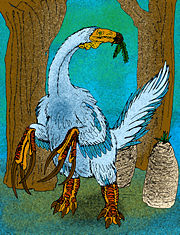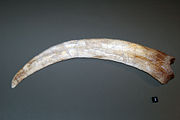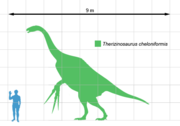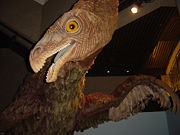Therizinosaurus
2008/9 Schools Wikipedia Selection. Related subjects: Dinosaurs
| Therizinosaurus Fossil range: Late Cretaceous |
||||||||||||||||
|---|---|---|---|---|---|---|---|---|---|---|---|---|---|---|---|---|
 |
||||||||||||||||
| Scientific classification | ||||||||||||||||
|
||||||||||||||||
| Species | ||||||||||||||||
|
T. cheloniformis Maleev, 1954 ( type) |
Therizinosaurus (pronounced /θɛˌrɪzɨnoʊˈsɔrəs/ 'scythe lizard', from the Greek therizo meaning 'to reap' or 'to cut off' and sauros meaning 'lizard') is a genus of very large theropod dinosaur. Known from very incomplete remains, it is estimated to have grown up to 9.6 meters (32 ft) long and reach 3-6 tonnes (3-7 short tons) in weight. Therizinosaurus lived in the late Cretaceous Period (late Campanian-early Maastrichtian stages, around 70 million years ago), and was one of the last and largest representatives of its unique group, the Therizinosauria. Its fossils were first discovered in Mongolia and they were originally thought to belong to a turtle-like reptile (hence the species name, T. cheloniformis — "turtle-formed").
Discovery and species

The first fossil remains of Therizinosaurus were discovered in the late 1940s by a joint Soviet-Mongolian fossil expedition, in the Nemegt Formation of southwestern Mongolia. The expedition unearthed several giant claws that measured up to a meter in length. These were described by Russian paleontologist Evgeny Maleev in 1954, who thought they belonged to a large, turtle-like reptile. However, it was not known what creature these belonged to until the early 1950s, when further expeditions unearthed more fossils: several more sets of claws and parts of the fore and hind limbs. Subsequent finds in northern China allowed paleontologists to assemble the general skeletal structure of the animal, which was determined to be a dinosaur and not a turtle.
The discovery of the enigmatic "segnosaurs", including Alxasaurus in 1993 and Beipiaosaurus in 1996, helped clarify the relationships of Therizinosaurus. Various theories had been proposed to explain the ancestry of the segnosaurids, with some scientists even suggesting they were descendents of the sauropodomorphs - but these new, well-preserved finds, which provided details about the bird-like pelvis, feet and skulls, helped confirm that segnosaurids belonged to the same group of theropod dinosaurs as Therizinosaurus (and were therefore re-named therizinosaurids), and that therizinosaurs were, more specifically, advanced, herbivorous maniraptoran theropods.
Characteristics
Though the fossil remains of Therizinosaurus are incomplete, inferences can be made about its physical characteristics based on related therizinosaurids. Like other members of its family, Therizinosaurus probably had a small skull atop a long neck, with a bipedal gait and a heavy, deep body (as evidenced by the wide pelvis of other therizinosaurids). Its forelimbs may have reached a length of 2.5 meter (8 ft) long. Its hind limbs ended in four weight-bearing toes, unlike other theropod groups, in which the first toe was reduced to a dewclaw.
The most distinctive feature of Therizinosaurus was the presence of three gigantic claws on each digit of its front limbs. These were especially large in Therizinosaurus, and while the largest claw specimens are incomplete, they probably reached just under 1 meter (3.28 feet) in length.
Paleobiology
The feeding habits of Therizinosaurus are unknown, since no skull material has ever been found that could indicate its diet. However, like other therizinosaurs, it was probably primarily herbivorous. It is thought that Therizinosaurus lived a similar lifestyle to modern gorillas or prehistoric ground sloths, using its long arms and sharp claws to reap food and foliage from trees.
There are other possible functions that could have been served by the claws of Therizinosaurus, such as defense against predators (e.g. the contemporary Tarbosaurus) and in intraspecific fighting, such as fighting for territory or for mating. The claws may even have served all these functions.

